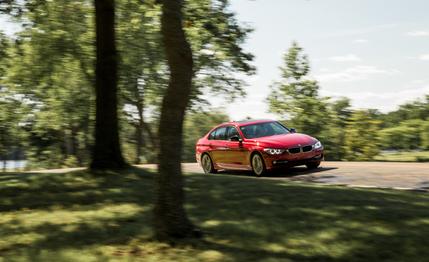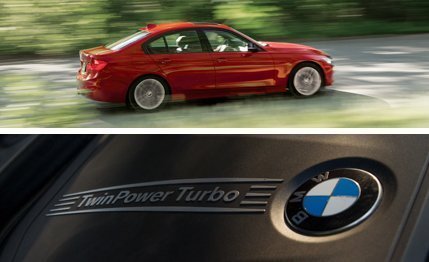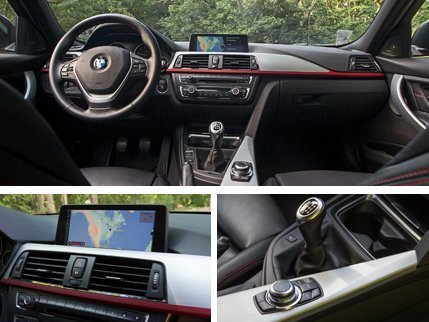 Long-Term Road Test Wrap-Up
Long-Term Road Test Wrap-Up
BMW’s 3-series sports sedan is hardly an enigma at this point. Its mission is driving pleasure; its soul, savvy engineering. BMW aims to improve each successive model’s performance, but every new generation carries the risk that the 3-series will deviate from the formula that earned it 22 straight 10Best awards. Need we remind you how BMW’s 5-, 6-, and 7-series models have swan-dived from lofty heights?

Our comparison tests are handy for judging any new car against its peers, but to bare the innermost secrets of the F30-generation 3-series, we launched a 2012 328i on a 13-month, 40,000-mile journey. Since the full M Sport Line package didn’t arrive until the 2013 model year, we spec’d our test car with a manual transmission, the $900 Adaptive M suspension (requiring the $2500 Sport Line trim that includes 18-inch wheels), and a few creature comforts. The $3600 Premium package brought a sunroof, power seats, and keyless entry. The $2550 Technology package added navigation and a head-up display. A $950 Premium Sound package contributed a Harman/Kardon surround-sound system with satellite-radio reception. Additional options—a split-folding back seat, heated front chairs, xenon headlamps, a parking-alert system, and Bluetooth and USB connections—hiked the $35,795 base price to just over the 50-grand mark. Marshaling restraint, and no small measure of self-respect, we didn’t sign up for the new $2050 automatic-parking system.
Our initial test results were a mixed bag. The new kid, powered by a 240-hp turbocharged 2.0-liter four, did trump the acceleration and top speed of the outgoing 328i, which was energized by a 230-hp naturally aspirated 3.0-liter inline-six. The zero-to-60 run dropped from 5.9 to 5.6 seconds, and quarter-mile results leapt from 14.6 seconds at 96 mph to 14.3 seconds at 100 mph. But the handling report card was disappointing. The new 328i’s greater mass (82 pounds more) and low-rolling-resistance tires resulted in significant braking- and cornering-performance degradation: 70–0 stopping stretched from 160 to 172 feet while skidpad stick fell from 0.92 to 0.88 g.

Logbook entries began with howls of protest. Staff members who’d owned and loved previous 3-series models were mortified that BMW replaced an adored six-cylinder engine with a lowly turbo-four, never mind the balance shafts and flywheel-mounted vibration absorbers. While there was consensus that the response to a jab of the accelerator or a run through the H-pattern was still entertaining, the new engine generated a laundry list of complaints: unseemly sounds following a cold start, annoying injector clicks, and power delivered in spurts instead of the six-cylinder’s rich flow. Senior online production manager Scott Mosher noted that “for $50,000, it shouldn’t feel as if I’m driving a Mini every time I start the engine.”
Compounding the loss of two cylinders, BMW added a gas-saving stop-start feature as standard 3-series equipment. We appreciate the potential benefits—eliminating fuel burn and exhaust emissions at red lights and traffic stops—but detest the execution. The shake, rattle, and roll when the engine refires prompted a reflexive hand motion from most of us: punching the disable button to kill this feature.
The new four-banger does reach stride in sixth gear. Noise and vibration at legal cruising speeds drop well below the wind-ruffle threshold. Following trips to Iowa and North Carolina, the logbook commentary sang praise with several reports of cruising mileage in the mid-to-high 30s. Combine that with a 15.9-gallon fuel capacity, and you’ve got a bladder-popping 500-mile range. Over the full 40,000-mile haul, we averaged 27 mpg, beating our 2006 BMW 330i long-term tester’s run through the 40,000-mile gantlet by two mpg. (That E90 3-series was powered by BMW’s lovely 255-hp naturally aspirated 3.0-liter six.)
rants and raves Alexander StoklosaThe 328i is also cheap to maintain. BMW’s Ultimate Service provides free inspections and oil changes for four years or 50,000 miles. Our car’s service reminder sent us to the desk at 14,000 and 29,000 miles for fresh lube. During the first visit, our dealer suggested new rear brake pads, but that turned out to be a false alarm. Not counting the installation and removal of winter tires, we made four additional stops for service. The 328i’s fuel door froze shut in the winter, an issue our dealer confirmed as common with this model. A factory service bulletin called for the installation of a new coolant expansion tank and an updated electronic control module. Near the end of the test, complaints of brake-pedal vibration and a noisy HVAC system resulted in our replacing the front brake pads and rotors and fitting a new blower motor, all under warranty. Aside from gas, our only out-of-pocket operating expense was $1384 for a set of tires at 40,000 miles.
Gripes focusing on driveline vibration began at 5900 miles and continued throughout the test. The buzz was subtle enough that it was more often seen, not heard or felt, as a rearview-mirror quiver. The tremor began at 75 mph and held steady through the upper registers. We doubt that the engine is to blame for this very un-BMW-like roughness. The cause could be deep within a tire, an out-of-balance driveshaft, or some other unhappy rotating component. Our dealer searched for the gremlin but never found it.
Cockpit quality and convenience met with our approval, but we did find one flaw associated with the electronic billboard dominating the top-center of the dash: Cool as they may be, you can’t switch the power and torque meters from metric to more palatable U.S. units. (This may have been rectified after our car was produced.)
While the E90 camp laments every ounce of mass and inch of length BMW added to the 3-series, the back half of the new car is one of its exceptional features. The rear seat provides excellent thigh support and ample head and leg space for two passengers, plus a temporary perch for a third rider. The 13-cubic-foot trunk has two secret storage bunkers under its hinged floor panel. A sensor included with the Premium package allows opening the trunklid by swinging a foot beneath the rear bumper. The $475 split-fold backrest option means you can swap passenger space for a nearly level, five-foot-long carrier deck. And the final touch—a 9.5-by-16.0–inch pass-through opening—raises the question: Who really needs a crossover or hatchback? (We’re looking at you, 3-series GT.)
Since we met the new 3-series early last year, it has fended off attacks in three comparison tests, two of which it won by slim margins. Still, two rivals—the Infiniti G25 and Cadillac’s ATS—beat this BMW in steering feel, handling, and fun-to-drive categories. The coup de grâce was administered by a Lexus IS350 F Sport in this year’s June issue, when a 335i finished second overall with last-place scores in steering feel, ride, handling, and driving enjoyment.

Our 328i logbook entries jibed with these comparison-test findings. Mike Dushane, past owner of five BMW 3-series models, called the new electrically assisted power steering overboosted. Others found the on-center precision adequate but deemed the absence of effort off-center and the overall feedback wholly disappointing.
At least the chassis fundamentals—anti-roll bars, dampers, and springs—are consistent with BMW’s past practice [see “A Tale of Two 3s”]. While the new 3er is slightly heavier, its unibody is one-third stiffer in torsion and 8 percent stiffer in bending, says BMW, which should provide a supremely capable base of operations. On balance, there’s not that much degradation in go, stop, and turn performance, but the new 328i feels less wieldy.
The concerns revealed by our inquiries include a softer ride, provided by larger suspension bushings that allow the front tires to give longitudinally when they smack a pavement expansion joint; and lighter steering effort, which supplies a more tenuous link from the road to the wheel. Since all control efforts—clutch, brake, and throttle—are keyed to the steering, the new 3-series always feels light to the touch. Even though it earned a spot on our 2013 10Best list, this F30 edition is definitely less engaging. It never begs you to split from work to take the long, twisty way home.